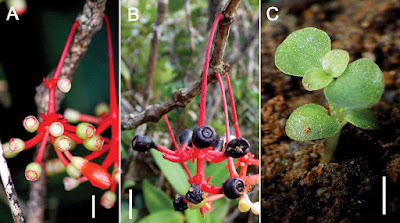 |
| Medinilla theresae Fernando
in Fernando, Quakenbush, Lillo & Ong, 2018.
|
Abstract
A new species, Medinilla theresae Fernando, from ultramafic soils on Dinagat and Mindanao Islands, Philippines is described and illustrated. The species is characterized by its terrestrial erect habit, non-setose nodes, 3-plinerved, lanceolate and coriaceous leaves arranged in whorls, cauline or axillary and pendulous inflorescences, rounded flower buds, 4-merous flowers, and straight anthers. It is compared with other similar species in the Medinilla pendula Merr. complex.
Keywords: Dinagat Island, Medinilla, Melastomataceae, Mt Hamiguitan, ultramafic soils
Medinilla theresae Fernando, sp. nov.
Diagnosis: This species is most similar to the Medinilla pendula species complex in its whorled leaves, 4-merous flowers, and pendulous inflorescences. It differs, however, in its secondary veins of leaves being distinct only on the adaxial surface, cauline or axillary inflorescences, and straight anthers.
....
Distribution: Thus far, this new species is known only from Mt Redondo on Dinagat Island and Mt Hamiguitan in the Pujada Peninsula on Mindanao Island, Philippines. Dinagat Island, Surigao del Norte Province, and the Pujada Peninsula form part of the same belt of the Eastern Philippine Cretaceous ophiolite and ophiolite complexes (Balce et al. 1976; Yumul et al. 2003, 2008; Tamayo et al. 2004) that are now large areas of ultramafic landscapes with metallic ore deposits (e.g., iron, nickel, chromium) and hosting a unique type of forest formation (Fernando et al. 2008).
Etymology: This beautiful new species is named in honor of Dr Theresa Mundita S. Lim, former Director of the Biodiversity Management Bureau, Department of Environment and Natural Resources of the Philippines, and now Executive Director of the ASEAN Centre for Biodiversity, whose dedication and commitment to protecting Philippine biodiversity is admirable. Director Lim has also been active in the international biodiversity conservation sector.
Edwino S. Fernando, J. Peter Quakenbush, Edgardo P. Lillo and Perry S. Ong. 2018. Medinilla theresae (Melastomataceae), A New Species from Ultramafic Soils in the Philippines. PhytoKeys. 113: 145-155. DOI: 10.3897/phytokeys.113.30027








